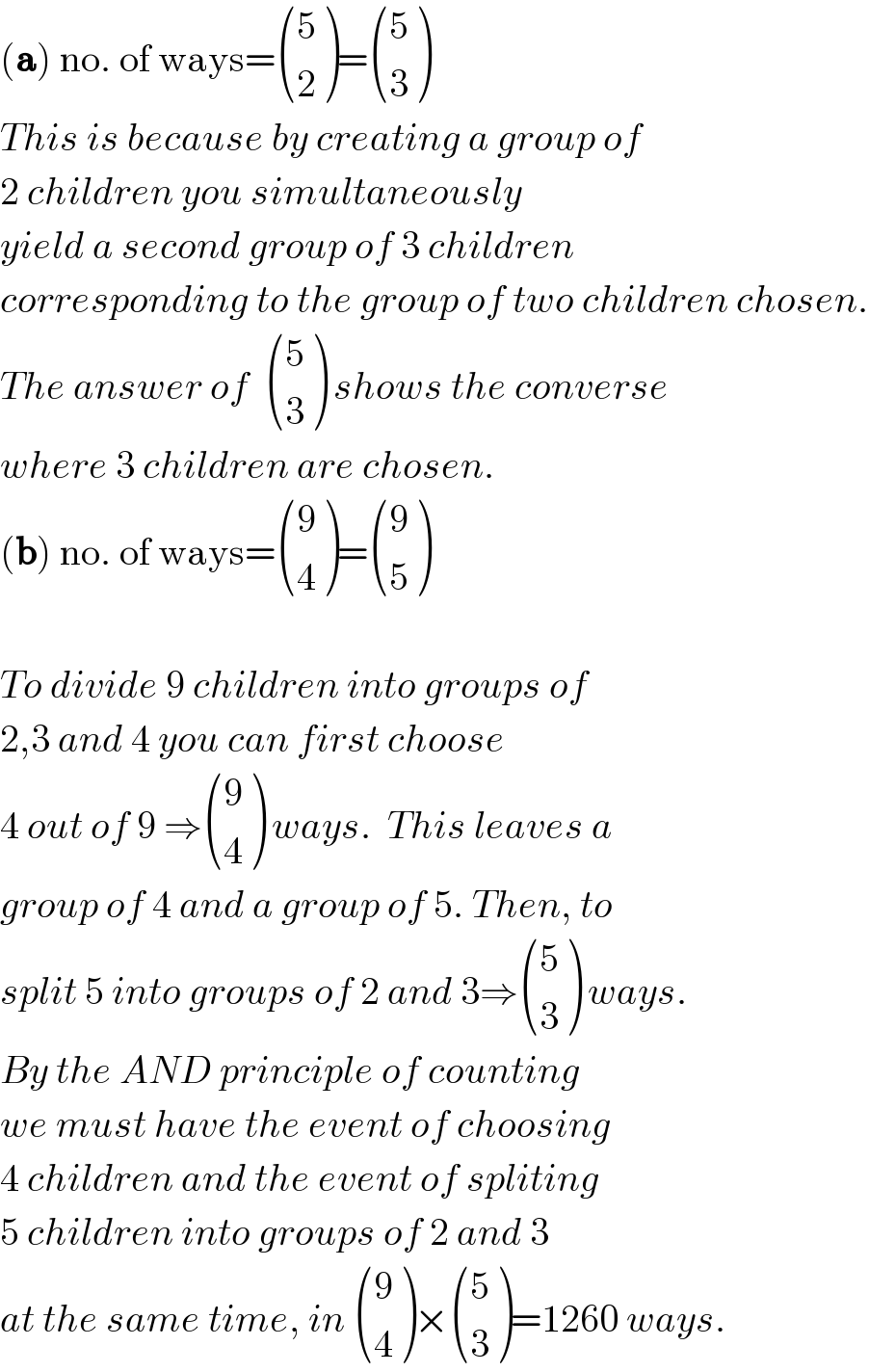
Previous in Permutation and Combination Next in Permutation and Combination
Question Number 5254 by Rasheed Soomro last updated on 02/May/16

$$\mathrm{Calculate}\:\mathrm{the}\:\mathrm{number}\:\mathrm{of}\:\mathrm{ways}\:\mathrm{in}\:\mathrm{which} \\ $$$$\left(\boldsymbol{\mathrm{a}}\right)\:\mathrm{5}\:\mathrm{children}\:\mathrm{can}\:\mathrm{be}\:\mathrm{divided}\:\mathrm{into}\:\mathrm{groups} \\ $$$$\mathrm{of}\:\mathrm{2}\:\mathrm{and}\:\mathrm{3}\:, \\ $$$$\left(\boldsymbol{\mathrm{b}}\right)\:\mathrm{9}\:\mathrm{children}\:\mathrm{can}\:\mathrm{be}\:\mathrm{divided}\:\mathrm{into}\:\mathrm{groups} \\ $$$$\mathrm{of}\:\mathrm{5}\:\mathrm{and}\:\mathrm{4}, \\ $$$$\mathrm{Hence}\:\mathrm{calculate}\:\mathrm{the}\:\mathrm{number}\:\mathrm{of}\:\mathrm{ways}\:\mathrm{in} \\ $$$$\mathrm{which}\:\mathrm{9}\:\mathrm{children}\:\mathrm{can}\:\mathrm{be}\:\mathrm{divided}\:\mathrm{into} \\ $$$$\mathrm{groups}\:\mathrm{of}\:\mathrm{2},\mathrm{3}\:\mathrm{and}\:\mathrm{4}. \\ $$
Commented by prakash jain last updated on 02/May/16

$$\mathrm{Dividing}\:\mathrm{5}\:\mathrm{children}\:\mathrm{is}\:\mathrm{groups}\:\mathrm{of}\:\mathrm{2}\:\mathrm{and}\:\mathrm{3}. \\ $$$$=\:^{\mathrm{5}} {C}_{\mathrm{2}} =\:^{\mathrm{5}} {C}_{\mathrm{3}} \\ $$$$\mathrm{Dividing}\:\mathrm{9}\:\mathrm{children}\:\mathrm{is}\:\mathrm{groups}\:\mathrm{of}\:\mathrm{4}\:\mathrm{and}\:\mathrm{5}. \\ $$$$=\:^{\mathrm{9}} {C}_{\mathrm{4}} =\:^{\mathrm{9}} {C}_{\mathrm{5}} \\ $$$$\mathrm{Dividing}\:\mathrm{9}\:\mathrm{children}\:\mathrm{in}\:\mathrm{group}\:\mathrm{of}\:\mathrm{4}\:\mathrm{and}\:\mathrm{5}. \\ $$$$=\:^{\mathrm{9}} {C}_{\mathrm{5}} ×\:^{\mathrm{5}} {C}_{\mathrm{2}} \\ $$
Answered by Yozzii last updated on 02/May/16

$$\left(\boldsymbol{\mathrm{a}}\right)\:\mathrm{no}.\:\mathrm{of}\:\mathrm{ways}=\begin{pmatrix}{\mathrm{5}}\\{\mathrm{2}}\end{pmatrix}=\begin{pmatrix}{\mathrm{5}}\\{\mathrm{3}}\end{pmatrix} \\ $$$${This}\:{is}\:{because}\:{by}\:{creating}\:{a}\:{group}\:{of} \\ $$$$\mathrm{2}\:{children}\:{you}\:{simultaneously} \\ $$$${yield}\:{a}\:{second}\:{group}\:{of}\:\mathrm{3}\:{children} \\ $$$${corresponding}\:{to}\:{the}\:{group}\:{of}\:{two}\:{children}\:{chosen}. \\ $$$${The}\:{answer}\:{of}\:\:\begin{pmatrix}{\mathrm{5}}\\{\mathrm{3}}\end{pmatrix}\:{shows}\:{the}\:{converse} \\ $$$${where}\:\mathrm{3}\:{children}\:{are}\:{chosen}. \\ $$$$\left(\boldsymbol{\mathrm{b}}\right)\:\mathrm{no}.\:\mathrm{of}\:\mathrm{ways}=\begin{pmatrix}{\mathrm{9}}\\{\mathrm{4}}\end{pmatrix}=\begin{pmatrix}{\mathrm{9}}\\{\mathrm{5}}\end{pmatrix} \\ $$$$ \\ $$$${To}\:{divide}\:\mathrm{9}\:{children}\:{into}\:{groups}\:{of} \\ $$$$\mathrm{2},\mathrm{3}\:{and}\:\mathrm{4}\:{you}\:{can}\:{first}\:{choose}\: \\ $$$$\mathrm{4}\:{out}\:{of}\:\mathrm{9}\:\Rightarrow\begin{pmatrix}{\mathrm{9}}\\{\mathrm{4}}\end{pmatrix}\:{ways}.\:\:{This}\:{leaves}\:{a}\: \\ $$$${group}\:{of}\:\mathrm{4}\:{and}\:{a}\:{group}\:{of}\:\mathrm{5}.\:{Then},\:{to} \\ $$$${split}\:\mathrm{5}\:{into}\:{groups}\:{of}\:\mathrm{2}\:{and}\:\mathrm{3}\Rightarrow\begin{pmatrix}{\mathrm{5}}\\{\mathrm{3}}\end{pmatrix}\:{ways}. \\ $$$${By}\:{the}\:{AND}\:{principle}\:{of}\:{counting} \\ $$$${we}\:{must}\:{have}\:{the}\:{event}\:{of}\:{choosing} \\ $$$$\mathrm{4}\:{children}\:{and}\:{the}\:{event}\:{of}\:{spliting} \\ $$$$\mathrm{5}\:{children}\:{into}\:{groups}\:{of}\:\mathrm{2}\:{and}\:\mathrm{3} \\ $$$${at}\:{the}\:{same}\:{time},\:{in}\:\begin{pmatrix}{\mathrm{9}}\\{\mathrm{4}}\end{pmatrix}×\begin{pmatrix}{\mathrm{5}}\\{\mathrm{3}}\end{pmatrix}=\mathrm{1260}\:{ways}. \\ $$
